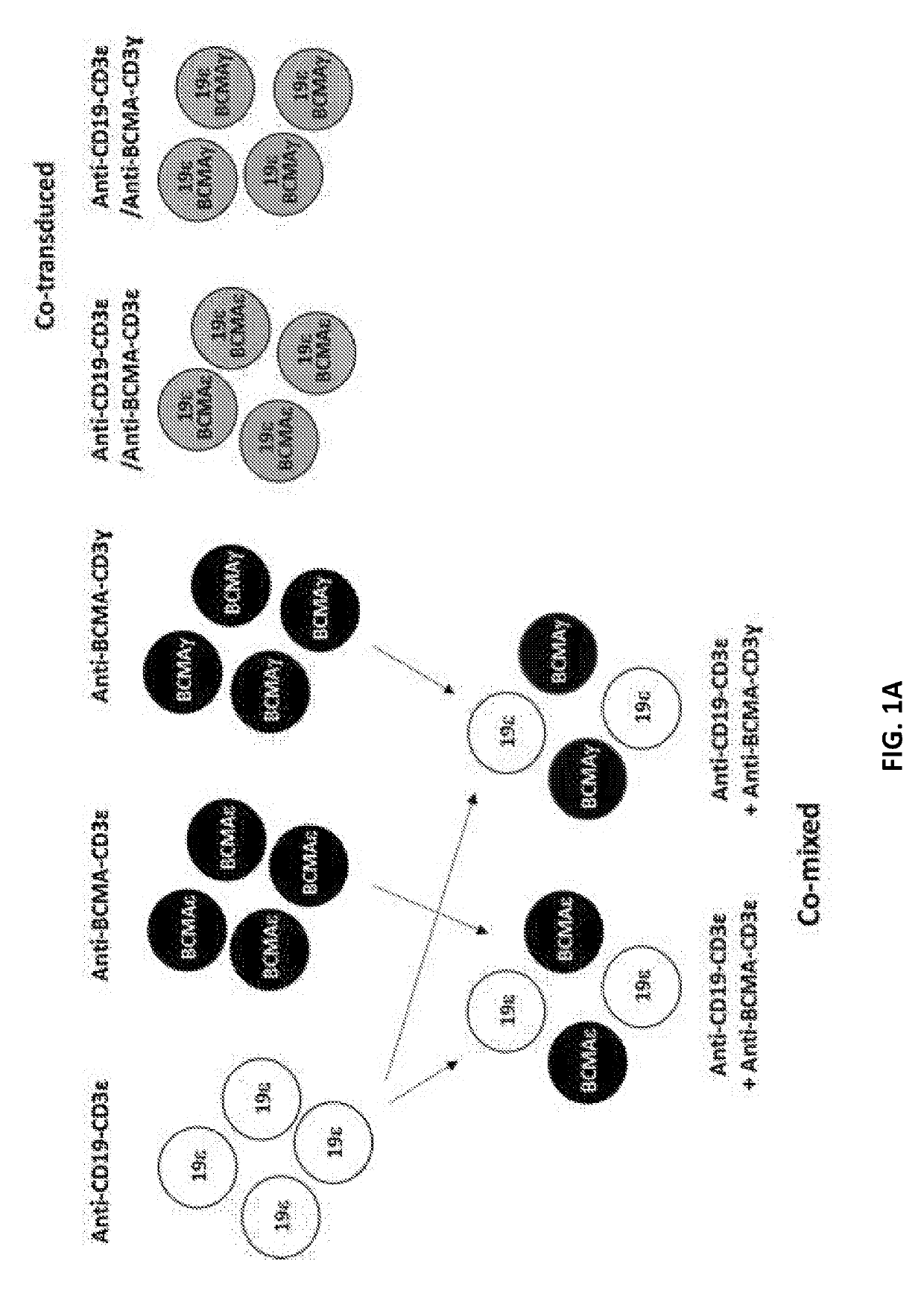Compositions and methods for tcr reprogramming using fusion proteins
a technology of fusion proteins and fusion proteins, applied in the field of compositions and methods for tcr reprogramming using fusion proteins, can solve the problems of difficult clinical effectiveness, serious side effects of traditional treatment options, and difficult to achieve clinical
- Summary
- Abstract
- Description
- Claims
- Application Information
AI Technical Summary
Benefits of technology
Problems solved by technology
Method used
Image
Examples
example 1
ructs
[0468]Anti-TAA TFP constructs are engineered by cloning one or more anti-TAA scFv DNA fragment or CD16 fragment linked to a CD3 or TCR DNA fragment by either a DNA sequence encoding a short linker (SL): AAAGGGGSGGGGSGGGGSLE (SEQ ID NO:2) or a long linker (LL): AAAIEVMYPPPYLGGGGSGGGGSGGGGSLE (SEQ ID NO:3) into, e.g., p510 vector ((System Biosciences (SBI)) at XbaI and EcoR1 sites. CAR constructs are generated by cloning synthesized DNA encoding an anti-TAA antibody (e.g., NKG2D or anti-ROR1), partial CD28 extracellular domain, CD28 transmembrane domain, CD28 intracellular domain and CD3 zeta into, e.g., a p510 vector at XbaI and EcoR1 sites. CD3ε TFP constructs disclosed herein comprise the sequence set forth in SEQ ID NO:97, which has an N-terminal truncation in reference to the full sequence (SEQ ID NO:4).
[0469]The anti-ROR1, NKG2D, etc. TFPs are generated as described above. For example, the anti-ROR1TFP constructs generated are p510_antiROR1_LL_TCRα (anti-ROR1 scFv-long link...
example 2
Sequences
Generation of Antibody Sequences
[0482]Provided are antibody polypeptides that are capable of specifically binding to the human TAA polypeptide(s), and fragments or domains thereof. Anti-TAA antibodies can be generated using diverse technologies (see, e.g., (Nicholson et al, 1997). Where murine anti-TAA antibodies are used as a starting material, humanization of murine anti-TAA antibodies is desired for the clinical setting, where the mouse-specific residues may induce a human-anti-mouse antigen (HAMA) response in subjects who receive T-cell receptor (TCR) fusion protein (TFP) treatment, i.e., treatment with T cells transduced with the TFP.TAA construct. Humanization is accomplished by grafting CDR regions from murine anti-TAA antibody onto appropriate human germline acceptor frameworks, optionally including other modifications to CDR and / or framework regions. As provided herein, antibody and antibody fragment residue numbering follows Kabat (Kabat E. A. et al, 1991; Chothia...
example 3
T-Cell Efficacy in a Human ALL Mouse Model
[0515]Primary human ALL cells can be grown in immune compromised mice (e.g., NSG or NOD) without having to culture them in vitro. Likewise, cultured human ALL cell lines can induce leukemia in such mice. ALL-bearing mice can be used to test the efficacy of human TFP.TAA T cells, for instance, in the model HALLX5447. The readout in this model is the survival of mice after intravenous (i.v.) infusion of ALL cells in the absence and presence of i.v. administered human TFP.TAA T cells.
PUM
| Property | Measurement | Unit |
|---|---|---|
| nucleic acid | aaaaa | aaaaa |
| cell surface antigen | aaaaa | aaaaa |
| stress response | aaaaa | aaaaa |
Abstract
Description
Claims
Application Information
 Login to View More
Login to View More - R&D
- Intellectual Property
- Life Sciences
- Materials
- Tech Scout
- Unparalleled Data Quality
- Higher Quality Content
- 60% Fewer Hallucinations
Browse by: Latest US Patents, China's latest patents, Technical Efficacy Thesaurus, Application Domain, Technology Topic, Popular Technical Reports.
© 2025 PatSnap. All rights reserved.Legal|Privacy policy|Modern Slavery Act Transparency Statement|Sitemap|About US| Contact US: help@patsnap.com



